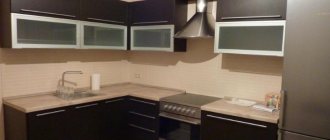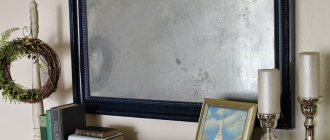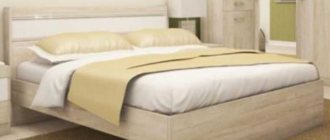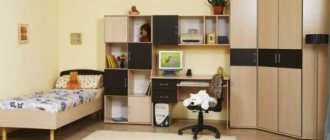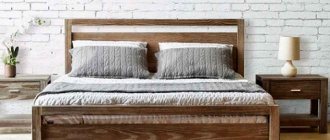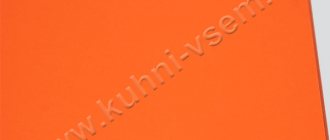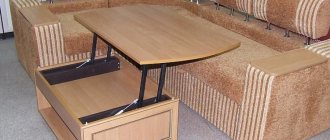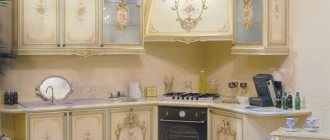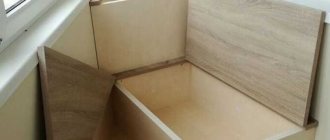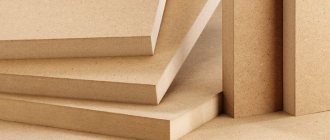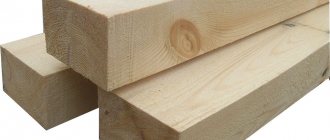Pros and cons of laminated chipboard body material
The advantages of chipboard are as follows:
- fairly inexpensive in cost;
- covered with many types of laminate;
- endurance to the influence of high temperature;
- it is very easy to process in the manufacture of cabinet furniture.
laminated chipboard
The disadvantages include:
- strong looseness of matter;
- poor retention of screws, especially when reused;
- nails are practically not held inside the slab;
- service life is no more than 10 years.
In the manufacture of this building material, the shavings may contain substances that emit formaldehyde in moderate quantities. They are quite harmful to humans.
This modern material is produced in large factories from wood shavings. It is ground and mixed with resin. Subsequently sawn into slabs.
What is MDF?
MDF is a finely dispersed fraction of wood (wood chips) compressed to the required degree of density. MDF is also called fine wood fiber. The material is made by drying wood, followed by treatment with special binders and hot pressing under high pressure.
To create MDF boards, only organic hardening compounds are used, thanks to which natural wood fibers are firmly glued together. These compounds include lignin, a natural substance released from wood when it is heated to high temperatures.
MDF is sold in sheets of different thicknesses and densities; the denser it is, and therefore harder, the more expensive it is.
The use of toxic substances, phenol and synthetic resins is not allowed at all stages of production. Thus, the result is an environmentally friendly material with excellent physical properties, which allows the production of inexpensive, high-quality doors.
MDF material is widely used for the manufacture of interior doors, due to its main advantages: ease of processing, environmental friendliness, preservation of its original shape over time and low cost. The modern market for MDF structures offers customers a wide range of options, which are classified by type of coating, type of construction, internal filling and design.
What is better and stronger for beds, cabinets, laminate and other furniture
Before gluing, it is necessary to place the panel on a flat surface. The chipboard must be cleaned of dust and other possible contaminants. Clean with a sanding machine. The film is gradually removed from the base. Apply carefully and smooth so that no air bubbles remain under the film.
Photo printing can be successfully applied to laminated chipboard. It looks very impressive.
Photo printing
Small shavings of this material are more reminiscent of cardboard. It is made by pressing fine wood dust. Mixed with resins and glue. One side is covered with laminate. The other, wrong side, is covered with glossy plastic, paint or various kinds of films.
Advantages of fine dispersion fraction ( MDF ):
- the dose of formaldehyde is minimal, within normal limits;
- more plastic, which allows you to make furniture in different versions;
- in production, urea resins modified with melamine are used, which brings the material closer to wood;
- the material can be moisture resistant , unlike chipboard, which strongly attracts moisture. Here's everything about moisture-resistant MDF for walls;
- characterized by comparative strength.
MDF
What to make from, what is better for furniture, MDF or chipboard? The cost of materials, the thickness of MDF and chipboard are often taken into account here. MDF is 1.5-2 times more expensive. It also needs to be further processed:
- paint;
- plastic;
- film.
Therefore, it is best to order furniture as follows:
- use chipboard for the body;
- It is best to install MDF on the front part of the facade or sliding doors. In addition, moisture-resistant MDF for bathroom furniture serves well in the kitchen.
The service life of wall panels for interior decoration of MDF is also not long. As we see in the question, which is better, MDF or chipboard for furniture, the optimal answer is a combination of materials. Types of MDF are determined depending on the need for their use:
- in dry rooms;
- in places where there is moisture.
This is a good combination of cost and quality. The material is affordable, high quality and reliable.
Manufacturing technology and properties
Chipboard is made using shavings and sawdust, which are combined with resin (formaldehyde). The slabs have different characteristics depending on the grade.
The amount of formaldehyde in particle boards is indicated by the formaldehyde emission class E1 and E2. Class E1 and E 0.5 are considered environmentally friendly (corresponds to GOST). We work only with safe laminated chipboard!
Chipboard is produced with a density from 300 kg/m3 (differing in looseness) to 600 kg/m3, which can be used to create furniture.
In order to reduce the harm of formaldehyde resins, lamination technology is used. A melamine film is applied to the surface, which makes the material non-hazardous and improves aesthetics. The film prevents the evaporation of formaldehyde, eliminating the negative impact on human health.
The production of MDF boards is carried out using modern technology.
Wood fiber is used as a basis and hot pressing technology is used. To make medium-density fiberboards, small sawdust is taken that can be pressed.
The surface of the MDF board is immediately smooth.
For comparison, chipboards are carefully sanded before applying the melamine film.
MDF board is also characterized by:
- reliability;
- resistance to damage;
- resistance to moisture;
- Suitable for the production of radius facades and milling.
MDF boards are environmentally friendly due to the use of lignin, natural resins, and paraffin as impregnation. At the same time, the formaldehyde content is minimal.
Simply put, the structure of chipboards can be compared to a material processed through a blender, and MDF can be compared to a product processed through a meat grinder. The density of MDF boards can be 600-800 kg/m3, which ensures strength and resistance to high humidity conditions. According to this parameter, MDF boards surpass the properties of solid wood.
Differences
What is the difference? A facade based on chipboard for a kitchen is less profitable than MDF.
MDF facades are:
- veneered;
Veneered
- painted;
Painted
- with plastic coating.
With plastic coating
A veneered façade is an MDF base coated with a thin layer of wood from the catalog and coated with varnish, matte or glossy.
In terms of technical characteristics, it is inferior to a painted facade, but at the same cost. It is necessary to apply veneer on both sides. In this case, its technical dimensions are preserved.
Applying veneer on one side is cheaper. But then, during operation, after 1-2 years the facade may bend. A well-painted façade is not cheap. Can be painted on either one or both sides . This does not affect its functionality and technical characteristics.
Today, facing brick is very popular when decorating the facade of a house. Here are its dimensions.
For finishing putty for painting, a special mixture is used. Here's all about the types of finishing putty.
Crushed stone is produced by crushing rocks into fractions larger than 5 mm. By clicking on the link you can familiarize yourself with crushed stone GOST 8267 93.
Plastic application of a millimeter layer in a variety of colors is the most common type of order. Plastic must also be applied on both sides. This façade can be mounted in different aluminum frames and with rounded ends. It is convenient and beautiful to cover MDF with PVC film.
If you apply plastic to MDF on only one side, the panel may also become deformed over time. The aluminum frame protects the inside of the MDF from water and moisture. This significantly increases the life of the furniture. In addition, such coatings are easy to clean and last a long time.
The most reliable facades made of MDF are those with plastic applied in an aluminum frame facade . Here about the MDF profile for frame facades. There is a wide range of color solutions - up to 500.
Furniture made of MDF with plastic coating in an aluminum frame
For more information about the differences between MDF and chipboard, watch the video:
For the kitchen: chipboard or MDF?
[rek_custom3]
MDF kitchen
What is a kitchen? This is a humid area with temperature changes. Steam, fat, hot plate, water. For such a difficult room, it is better to choose a material that is more durable and resistant to various changes - MDF.
MDF facades come in two types:
- Covered with film . The film version is cheaper, but there is a risk that near high temperatures the film will swell and begin to come off.
- Painted MDF . The price is higher than for film ones. Provided the correct coloring has an ideal appearance. Resistant to moisture and high temperatures. However, with a strong impact, the paint can be damaged.
An MDF kitchen can only disappoint if the manufacturer has skimped on quality. Unfortunately, this is difficult to determine visually.
Kitchen made of laminated chipboard
If, nevertheless, the choice fell on the inexpensive segment of kitchens made of laminated chipboard, then you should pay attention to some elements:
- The ends of the facades . They must be well glued. It is best if the ends are made of aluminum profiles or PVC film with a thickness of 2 mm or more. Such ends will not allow dirt and water to get into the structure of the slab. The cheapest option for ends is paper glued with an iron. It is short-lived and comes off quickly. This kitchen won't last long.
- Plate type . It should be multi-layered. There are one- and two-layer slabs; they are, of course, cheaper, but inferior in quality.
- The structure of laminated chipboard is loose, so you should not rehang wall cabinets several times . They may simply not be able to stand it.
The best budget option is a combination of MDF and chipboard. In this case, the frame is made of chipboard, and the facades on which the strongest impact occurs are made of MDF.
Painted facades
Painted facades can be ordered in a wide range of colors. They can be:
- matte;
Matte
- chameleon;
Chameleon
- pure color;
- steel metallic.
Steel metallic
The advantage of such facades at a fairly high price category is their long service life.
A high-quality facade cannot contain foreign inclusions or roughness. Visual inspection shows a perfectly mirror surface.
This is achieved by grinding at different levels:
- primer;
- dye;
- varnish
This façade is made using special technology and requires precise execution of all stages. The resulting result will please the owners for a long period of time. It is for this type of MDF that it does not matter whether it is painted on one or both sides. Such panels are not afraid of water, steam, or moisture.
Experts who make furniture do not recommend choosing facades based on chipboard or plastic with its application on one side. Caring for a painted facade requires cleaning approximately every six months. Ease of maintenance depends on the ergonomics of furniture designs. Surface care is simple.
A regular window cleaner will work for this. If any grease stains remain, you can wipe them with a sponge or cloth with detergent.
Surface cleaning
The surfaces are fairly easy to clean and are not susceptible to heavy contamination.
Advantages and disadvantages of materials
The advantages of MDF are the following indicators:
- density and plasticity;
- resistance to mechanical loads;
- environmental cleanliness;
- visually similar to solid wood;
- low cost.
A characteristic feature of the material is the ability to process the surface with cutting and drilling tools, bend it to obtain radius facades, sand it, cover it with PVC film, paint it in any color using matte and glossy enamel. To improve moisture resistance, fire resistance and other properties in the manufacture of MDF, special impregnations are used. MDF is cheaper than solid wood, but more expensive than chipboard. The last factor is considered the only disadvantage of the material.
The following characteristics are considered to be the advantages of laminated chipboard:
- resistance to temperature changes and mechanical stress;
- variety of colors;
- imitation of the texture of natural wood;
- laconic appearance;
- budget price.
The disadvantages of the material include low moisture resistance and the presence of formaldehyde resins. Laminated chipboard is prone to chipping on the surface and cannot be finely processed or milled, which precludes smooth angles and bevels in furniture making.
Characteristics of the cost of materials
The most budget option is chipboard. Mostly shelves are made from it. If you make a facade, be sure to apply lamination. This kind of furniture is the most inexpensive.
Advantages – the cost of such furniture. The absence of expensive accessories also reduces the cost of purchase. For this price category the furniture is quite acceptable.
It is imperative to choose good chipboard.
MDF is covered with a special vinyl film for facades and it can be:
- matte;
- glossy;
Glossy
- with effects.
If the film is exposed to heat, it will peel off. It is recommended to choose high-quality film and good adhesive. Such furniture will last 5-7 years.
Facades are easily scratched. However, kitchens in this price category also have a corresponding service life.
What is "chipboard"
The manufacturing technology of chipboard - “chipboard” (“DSP”) involves hot pressing of wood particles (mainly medium-disperse chips) based on mineral binders. Today, the production of single-layer and multi-layer materials has been mastered. The abbreviation “LDSP” means laminated particle board, for the decorative coating of which melamine film is used. The manufacturing technology involves laminating the surface simultaneously with pressing the base material (plate). Modern products can have a smooth surface, or they can be embossed, quite accurately imitating the texture of natural wood.
Designer tips - what is the difference between materials
Designers can also advise which furniture is better, made of MDF or chipboard. If you take two samples of facades, at first glance you may not immediately be able to determine what they are made of. Both facades are budget alternatives to using expensive natural wood.
Thanks to the fashion for the Art-Decor style, when classics are combined with modern fashionable materials, you can successfully play with such facades. Paint them in loft, minimalism, and achieve very interesting effects.
Straight-shaped facades are most often used in modern interiors and rectilinear design projects. The most popular is painted glossy or veneered MDF.
Modern fashion trends tend to combine bright colors with MDF with natural wood veneer. It is permissible for a predominance of both a dark bottom and a light top, and vice versa.
The top drawers should not visually appear massive and large. Laminated MDF panels for walls completely replicate the texture of natural wood. Visually it is difficult to find the differences. These panels can also be used to decorate the ceiling.
For a kitchen, it is necessary that the material is not only beautiful, but also practical. Matte painted facades from Italian designers are in fashion now.
Ultra interesting design options are now being created with matte facades. Gloss is easier to maintain. Various contaminants are less visible on it. For practical people, it is better to choose furniture from glossy MDF panels. Using the advice of designers, you can successfully purchase furniture.
When choosing furniture made from chipboard and MDF, the difference will be in cost and quality . However, both panels can be successfully used if you need to purchase budget furniture.
How to choose MDF doors by design?
Classification of MDF doors by their design
There are the following types of MDF interior doors on the market, depending on their design:
- Panel smooth. Doors of this type consist of three parts: a frame, an internal space filler and a lining. The frame provides for the insertion of handles, locks and hinges, therefore it is made of laminated veneer lumber, which is located around the perimeter of the door. MDF sheets are laid on top of the frame, resulting in a space that is filled with corrugated cardboard (honeycomb core) or hardboard. This type of filling makes the door lighter, but the structural strength indicators are reduced (they may not withstand physical stress).
Smooth panel door reinforced with pine beams without honeycomb filling
- Panel milled. This type of structure is made using the same method as the previous type, however, there is milling on the surface of the door leaf (decorative patterns, bends, lines). For milled structures, higher density MDF is used or additional sheets (boards) are applied, since it is important that the material does not crumble during milling.
Relief milling in a smooth panel door leaf made of MDF
- Tsargovye. Tsar doors also consist of a wooden frame, but they are filled with hollow MDF, which significantly increases their weight and performance. The cost of such products varies depending on the integrity of the frame and the density of the MDF sheets. Cheap models have frames made not of solid wood, but of MDF, and the coating is of low quality. For door models in the mid-price category, the frame consists of laminated pine timber, and the door is finished with a medium-quality coating. The frame of the most expensive side doors is made of laminated veneer lumber (pine), and the panels are made of high-density MDF. Such doors are usually reinforced with special LVL inserts. The high cost of drawer structures is also confirmed by the quality of the coating and the presence of decor.
Tsargovaya (prefabricated) door coated with eco-veneer
- Paneled. The frame in them is also made of solid pine, and the panels are made of MDF sheets, however, they have a frame (frame), which is made from various types of trees (birch, alder, pine). There are combined strappings made of solid wood and MDF. Instead of panels, glass is often used in glazed versions. In interior paneled doors, the number of panels can be different (from 2 to 10 pieces). Glass and panels are inserted into the frame (frame) with a gap (this is in case of changes in size due to moisture).
Installation of three-panel MDF doors with painted veneer
- Molded. Doors of this type have glass that performs a load-bearing function. The glass itself is multilayer (for example, Triplex), which has increased strength. Molded doors consist of two or more parts, fastened together thanks to glass that is inserted into a special groove in the door leaf. Glass can be frosted, shaded, black, bronze, and is also often decorated with decorative stones, drawings, engravings and ornaments.
Molded interior doors with narrow glass and mirror
Molded door with triplex glass in section
All of the above types of MDF doors are an optimal replacement for solid wood structures. In addition, MDF products, unlike the latter, do not change their shape and appearance over time and in conditions of high humidity, and the price is much lower.
Note! Almost all modern door leaves have MDF in their construction, with the exception of doors made of 100% solid wood, and prices can vary significantly. If you want to choose a model based on your budget, go to the catalog of interior doors of the online store “Into the House”, whose employees provided photographs and materials for this article .
What to look for when choosing interior doors according to design?
MDF doors are available in any design and price category. To choose a quality product, it is important to pay attention to the following characteristics:
- Thickness of MDF boards. This characteristic determines not only sound insulation, but also the durability of the product. If the installation of structures is planned in load-bearing walls, then it is important to purchase side doors, which have a frame made of solid wood and panels made of dense MDF sheets. Such doors withstand physical stress well and provide excellent sound insulation.
- Molded products. To achieve maximum sound insulation, in addition to the internal filling of the door leaf, it is important to pay attention to the box beam - it must contain sealing rubber bands. Setting a threshold is more effective (half of the door frame pillar is used for this).
A frame installed in the opening with a seal and a hung door leaf
- Quality of panels and glass. These elements must be firmly held in the frame - curvature and loosening indicate low quality of the product. When choosing glazed options, you should pay attention to the thickness of the glass - it should be more than 4 mm, and it is better to give preference to molded doors that use Triplex glass; they are durable and safe. Frosted glass is impractical in everyday life, since it is difficult to remove greasy stains from them.
- The quality and placement of the frame. In paneled doors, the frame should be positioned perfectly flat on the door leaf, the gap between the frame and the panel or glass should be no more than 2 mm.
When choosing an MDF door, quality, design and price play a major role. The last factor is especially worth considering, since a cheap MDF door (up to 5,000 rubles per door leaf) is inferior in quality to a more expensive one (from 9,000 rubles). The higher cost of the canvas is due to the use of sheets with a thickness of 3 to 6 mm for its production. The cost of doors is also affected by the presence of glass, patterns, milling and other decorative items.
What is the difference between children's furniture made from MDF and laminated chipboard?
To successfully organize a room for babies, it is important to take into account the advice of doctors. When the baby grows out of his cozy crib. It's time to take care of arranging the space in his room.
To do this you need to choose furniture that will:
- comfortable;
- comfortable;
- safe.
A grown-up baby already needs:
- a table at which he will create the first masterpieces of his creativity, and later do his homework;
- comfortable bed;
- wardrobe with drawers for clothes and toys.
All furniture for a children's room should be made from environmentally friendly materials. In addition, you cannot place furniture in a child’s room if the child is allergic to one of the materials from which it is made.
The first thing you need to pay attention to when choosing furniture for a nursery is the quality of the furniture. Products must be certified. The quality must be factory made. The more modules, the more opportunities to create the ideal children's room with areas for relaxation, games and activities.
Furniture for the nursery
It is necessary that all furniture is suitable for the child’s age. So that he can get his things or toys from the closet or table.
The chair and table should be such that the baby’s posture develops correctly.
If the size of the children's room does not allow placing full-fledged furniture, the solution would be to purchase modular furniture - a transformer. For example, choosing a bunk bed helps create personal space for each child. It can have a built-in linen drawer and a closet.
Bunk bed
Do not clutter the room with unnecessary pieces of furniture. Only necessary things. If you choose the right furniture, children will feel happy and try to complete tasks on time.
Environmentally friendly materials for facades and product bodies:
- chipboard;
- mdf;
- natural wood.
E1 is the highest safety class of chipboard. If furniture for children is made from this sheet, you don’t have to worry about the quality of the panels. This material is moisture resistant. It is perfect for furniture frames and shelves. It is covered with chipboard with PVC film.
E1
MDF is better suited for making furniture doors. This material is durable and wear-resistant. It is not afraid of moisture and does not deform over time. Resistant to scratches and dirt.
MDF or chipboard for the bedroom
[rek_custom4]
MDF bedroom furniture
In the bedroom, the microclimate is always favorable, there are no sudden temperature changes, so the resistance of furniture to adverse influences is not so important. This is where safety comes to the fore. After all, people spend a lot of time in the bedroom. Especially when it comes to a children's room, where the child spends most of his time. It is important that the furniture is safe. MDF can have various decorative coatings:
- The plastic coating will protect the color from fading and add any texture.
- The film coating allows you to choose any color, even iridescent and chameleon.
- Veneer covering. Furniture with such a coating always looks good, because veneer is a wood material and has the texture of wood.
Bedrooms made of laminated chipboard
You shouldn’t completely write off laminated chipboard; given a certain quality, this material is not inferior to the more expensive MDF. When choosing furniture made from chipboard, you should pay attention to some nuances:
- Certificate of quality. In Europe, the use of E2 class chipboard for home furniture is prohibited. There is no such ban in our country. Therefore, it is imperative to establish a safety class or formaldehyde emission class. It must be E1.
- All sections must be protected with film. There should be no unsightly joints or seams.
- The price should not be too low relative to competitors. If a manufacturer puts a too low price on its product, it means that in the pursuit of profit, the production technology was violated, and the safe composition was replaced with its own recipes with unknown and most likely toxic elements.
Chipboard and MDF have their advantages. Having studied the properties of these two materials, making a choice in favor of one is not so difficult. What is better MDF or chipboard for the kitchen? Only the buyer decides; the main thing is that the furniture is strong, durable and safe.
What to consider when choosing kitchen furniture made from MDF and chipboard
If the kitchen is spacious, choose a large table. It can be placed in the center of the room when guests arrive. Several chairs can be placed around the table. It is good to choose oval or round tables.
Table models should be combined with the style of other kitchen furniture. A transformer is good for small rooms. It does not take up much space when folded.
All materials from which the furniture is made must be resistant to steam and moisture. For such furniture, choose only high-quality chipboard or MDF materials.
So that they do not become deformed over time. By choosing glossy surfaces, you can ensure a minimum of cleaning worries. On such furniture stains from grease and other contaminants will not be visible. Matte surfaces are more whimsical, although today they are in fashion. Simple tips for choosing a custom-made kitchen.
Disadvantages of laminated chipboard
- Due to the large number of large chips and heterogeneity of the structure, chipboards are prone to chipping of individual particles and the appearance of chips. Products can only be sawed in straight lines. They are not subject to fine milling or laser engraving. Therefore, it is very rare to find beautiful furniture facades made of chipboard, with figured cutouts, 3D relief images, and complex patterns. Mostly even, smooth doors are made from this material, suitable for modern styles.
- If water regularly gets into the joints and seams, the surface in these places swells and bulges into a hump. The product increases its volume up to 30%. The film begins to peel off. Inside the slab, the mass becomes loose, crumbles, and black mold appears. To avoid this, you should choose furniture with laser-cut edges (soldered joints). Such products are more durable. In addition, spilled liquids must be promptly removed by wiping the surface with a soft, clean cloth.
- Due to the low density of the base, the places where the fittings are attached gradually crumble. The fasteners begin to move freely in the socket. Furniture made from chipboard is not intended for frequent assembly and disassembly. It is enough to transport the set 1-2 times to a new place of residence, and it will warp in the most unimaginable way due to completely loose fastenings. To remedy the situation, you can use wood glue or use thicker screws. Or initially purchase products that use not ordinary fasteners, but bolts with wide washers.
- Low-grade types of chipboard negatively affect the health of children, adults, and pets. To produce the cheapest materials, large amounts of resins that emit formaldehyde are used. If new furniture has a specific, chemical smell, it is better to refuse the purchase. Living next to such a time bomb is simply dangerous.
Perhaps the most important disadvantage of laminated chipboard is its short service life. Such furniture lasts on average 5-7 years, subject to the rules of operation.
Advantages of MDF
- Since formaldehyde resins are not used in the production of MDF boards, they are much safer than chipboard. In fact, it is the same wood, with a small content of natural or urea resins, only more uniform and durable. The material is used in the manufacture of children's furniture, cribs and changing tables for newborns, products for children's and medical institutions. By purchasing furniture made from high-quality MDF, the buyer can be completely confident in its safety for health.
- MDF, even in its natural, uncovered form, is not afraid of water. Its dense structure simply does not allow liquids to be quickly absorbed, unlike some types of natural wood and, especially, chipboard. And an additional protective coating in the form of a laminating film or veneer gives it excellent moisture-resistant characteristics. Even many hours of exposure to puddles of water or other liquids are not dangerous for MDF surfaces. That is why furniture made from this material is recommended for “wet areas” - kitchens, bathrooms, swimming pools, toilets, dressing rooms.
- Dense sheets can be bent if necessary: they do not break or crack, and retain their shape perfectly. This feature is widely used in the manufacture of curved or concave facades and other elements.
- MDF sheets, thanks to their homogeneous structure, make it possible to produce richly decorated furniture facades. They perfectly withstand all types of processing: sawing, shape cutting, milling. The possibilities of milling this material are limited only by the designer’s imagination. Craftsmen form products with relief figures and designs, carve complex recesses and patterns, apply entire pictures to slabs, and make carved platbands and moldings.
- The edges and front part of the products have no joints or seams, as they are covered with one sheet of protective and decorative material. That is why products made from MDF successfully resist moisture and chemicals. The coating is so dense that it is very difficult to scratch or make a dent.
- You can spill water, caustic fruit acids, or soda solution on MDF countertops and kitchen aprons. If you wipe up the resulting puddle in a timely manner, there will be no consequences for the coating.
- Furniture made from MDF perfectly withstands repeated assembly and disassembly when moving and moving to other rooms. In this respect, it is comparable to products made from natural solid wood.
- Consumers are offered a huge number of finishing options: PVC film with the most fantastic shades and textures; glossy, mirror, matte and semi-matte coatings; products with metallic, mother-of-pearl effects, interspersed with sparkles and metal threads, patina; veneer from elite wood species; surfaces that perfectly imitate any type of wood, stone, textiles, leather. Even the most picky buyer will definitely find a product to his liking!
